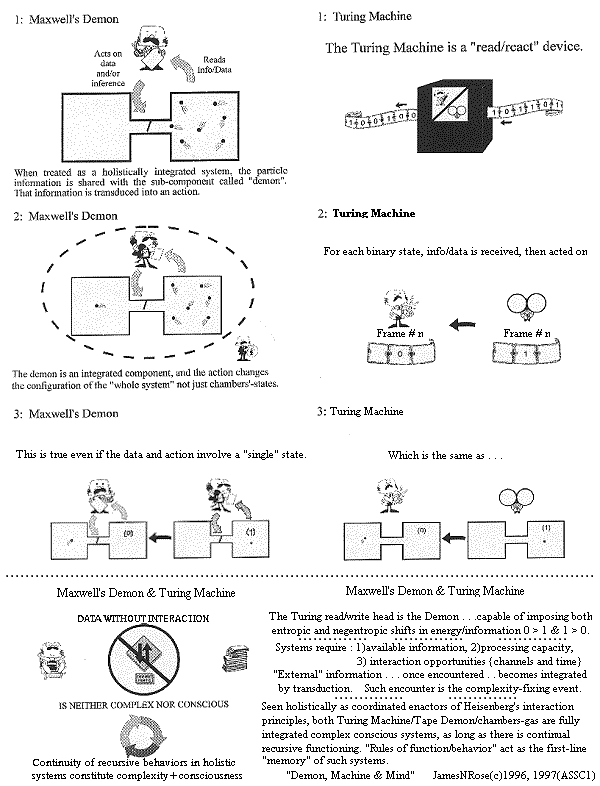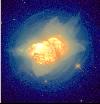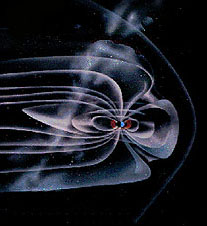: The Turing Machine is a read/react device.
: For each binary state, info/data is received, then acted on.
: Which is the same as 1 ![]() 0 , 0
0 , 0 ![]() 1. (tacit 0
1. (tacit 0 ![]() 0, 1
0, 1 ![]() 1)
1)
: Maxwell's Demon reads info/data then acts on it (or inference).
| The INTEGRITY PAPERS | UIU Group | ceptualinstitute.com |
Maxwell's Demon & The Turing Machine Their Processes/Dynamics are
Identical,
|
presented at A.S.S.C. Conference, June 13-16, 1997 Claremont College, Pomona CA 91711
"Demon, Machine & Mind"
| A related paper which proposes
a replacement alternative to the Turing Test may be found at: "The Conscious Continuum" |
Abstract:
Empirical data is typically crossed referenced against conceptual models which frame the information and make it comprehensible and usable. The models are then open to scrutiny to see if accurancy is maintained for future or educed data. In regard to Consciousness there are several major models/exemplars: Maxwell's Demon, the Turing Machine, and Quantum Mechanics. An evaluation of these models is presented which compares their system dynamics characteristics, with the conclusion that they share a significant overlap of functional qualities re information transferences.
These characteristics are discussed and specified. An alternative to the Turing Test is then proposed which takes them into account and advances us to the more general proposition, "If system S satisfies none or some or most or all of the specific criteria in question, then we can authentically deduce that a holistic consciousness is not or is objectively present there." We do not have to rely upon "experiencing another entity's consciousness" in order to confirm its existence. Neither are we limited to intuitive satisfactions, which vary from person to person. We move from "immitation which fools the evaluator" to a reliable empirical checklist.
At the moment, the field is faced with resolving the so-called Hard Problem, which can be re-phrased thus: We have scientifically/mathematically accepted the Gödel limitation that a closed system cannot verify the truth (functional validity) of its own axiomatic fundamentals, yet, we behave otherwise ... (human) consciousness self evaluates and self confirms its own consciousness, in a very non-Gödelian way. A more explicit criteria system may not explain why any given system is self-referentially conscious, but at least it enables us to accept that it is conscious.
Introduction:
The conventional version of mind vs matter places rules of behavior as distinct from the information the rules "act on". Maxwell's Demon brings new energy and information to an existing system. The read/write-head of the Turing Machine does also. But what if that version was incomplete? Is there an alternative scenario that might shed light on "consciousness"?
Yes, there is.
The Demon Scenario and the Turing Machine are really holistic integral systems, which are intrinsically identical with each other, and harbor the primal factors and relationships indicative of "conscious systems".
Whole-System Evaluation:
Consciousness is a temporal process. Any conscious system must have the components to handle the information, as well as the information per se. Without information flow there is no consciousness. The Reading Head and the Demon are not conscious, they embody enactable capacity and potential.
Recursive ongoing information/energy interactions are tantamount to recursive ongoing consciousness.
The act of encountering molecular or tape-state information, and the information, with resulting effects -- all together -- contribute to the existential presence of consciousness.
Once we understand the relational components and functions of consciousness, we can begin designating general and then specific criteria. With a constituted list of requirements we can affirm that a consciousness is present in an observed system. It is not required to experience a consciousness -- one external to our own -- in order to verify its existence, any more than we need to walk on another celestial mass in order to verify that gravity is present there.
If reasonable criteria are met, then presence of consciousness can reliably be inferred.
Integrated recursive dynamics is the hallmark of Consciousness. Behavior which is looped, continuous and pervasive, not linear, isolated and alternating.
The general test for consciousness is:
Can a system be constantly open to information flow input, and adjust its own behaviors and activities to conform with changing conditions ... both internal and external to itself?
1) What energy/information ranges are the structures of a system capable of interacting with? What information is it sensitive to?
2) What and how many hierarchic levels does a system contain? What are the capabilities or limitations of each level? Does one level (even an internal one) dominate the overall behavior of the assembly (even taking precedence over an "emergent" level)?
3) Is a system in its best environment? (including sub- & supra- levels)
4) What capabilities or limitations are there, as related to transduction and information coding? ... internally and externally.
5) Are there time constraints which frame behaviors and activities? Do reaction times factor into successful behaviorings/functionings?
6) Is the information being stored/processed salient to the survival of the structure/functioning of the system itself? What portion of a system's operations are for structure maintenance vs the portion used to interact with external dynamics?
7) Does the system generate new agendas, as allowed by potential?
a) connections: i) physical ii) relational
b) questions: i) does it reorganize data and then test that
reorganization by "initiating" new encounters with its
environment (to gather new data for future evaluation and comparation)?
8) Does the system seek energy/information? Does it act as a heat-sink for information? Ie, does it contain enough empty internal eigenstates capable of holding relational information, and therefore accumulate information by enacting an entropy gradient vis a vis the external environment?
And now, the most salient interrogative:
9) Given standardized circumstances, problems, or information to encounter, do "identical" representatives of a system behave "significantly differently" from other representatives?
Do outputs and/or responses display statistical variability among the membership, or are reactions rigidly fixed and identical? Or are they so extreme as to qualify for novel classification: species, family, class, etc.?
Consciousness is intimately integral with the ability of a system to maintain its Integrity...
|
~ ~ ~ ~ ~ ~ ~ ~ ~
Texts for Figures
: The Turing Machine is a read/react device.
: For each binary state, info/data is received, then acted on.
: Which is the same as 1
0 , 0
1. (tacit 0
0, 1
1)
: Maxwell's Demon reads info/data then acts on it (or inference).
When treated as a holistically integrated system, the particle information is shared with the sub-component called "demon". That information is transduced into an action on/of the system.
: The Demon is an integrated component, and the action changes the
configuration of the "whole system", not just the chambers' states.: This is true even if the data and action involve a "single" state
1
0 and 0
1 (tacit: 0
0, 1
1 )
: Data without interaction cannot be consciousness.
Neither is simple energy/information transfer or wave collapse.
Under current prevailing viewpoints, the read/write head is the demon . . . capable of imposing both entropic and negentropic shifts of the energy/information:
1
0 and 0
1.
Inter-action is the primary characteristic of consciousness.
Data without process is static, potential.
Since transduction of information/energy is a Heisenberg phenomenon - transference activity at an intersection (of spacetime) - it is the "on-goingness" of transaction which epitomizes existential "consciousness".
Seen holistically as coordinated enactors of Heisenberg's interaction principles, both Turing-Machine-with-tape and the Demon-with-chambers are fully integrated conscious systems . . . as long as there is continual recursive functioning. The "Rules of Behavior" act as the "memory" of such systems, whether "data" is present or absent.
: Continuity of recursive behaviors in a holistic system constitutes
"Consciousness".
There must be information available. There must be processing capacity. There must be accessibility: channels & conditional opportunities.
So-called "external" information/energy -- Buber's "I-Thou" -- once encountered -- become part of the integrated holism. Regardless of specific mechanisms. Regardless of complexity. Consciousness is an intangible. Real, but intangible. Existential enactment. Phenomenological behaviorings.
Demon, Machine & Mind. ©1973,1995,1997

Alternative to Quantum Consciousness
Under the current physics perspectives on consciousness, led variously by Wigner, Frolich, Stapp, Hammeroff and Pen, Josephson, among others, concerns focus on 2 characteristics identified with "consciousness". The first is its quality of temporal asymmetry, being a seemingly very deterministic time-forward phenomenon. Yet it is built on organelles and organs which are sensitive to quantum perturbations. So, consciousness is treated as the premiere biological venue in which to resolve the decades and century old problem of thermodynamic determinism vs quantum mechanical stochasticity.
Stapp in particular evaluates the qualé-conscious event as being a "collapse of the wave function" (to put it in theoretical terms). Now that is a possibility because as of this moment in time, that is the only event recognized as a transduction mechanism, changing QM states into thermodynamic sequences. However, in light of the philosophical evaluation in this paper, consciousness necessarily must be a continuum of transitting information (nee, energy).
That means that even with the Hamiltonian super-position quality of wave functions under QM analysis, consciousness requires the on-goingness of wave functions, not a new-binding process that somehow re-connects separated quantum collapses.
The above Demon-Turing analysis indicates that it is reiterated self-resonating fluid wave functions which enact "consciousness". Quantum non-locality and such may play significant roles, but the backbone framework of consciousness rests on some mechanism which is tautologically self impacting and reinforcing. Now that may be anathema to generations of philosophers who decry bootstrap escherian verification. Yet existentially, we cannot ask that systems are insensitive to their own functions. Indeed, no behaviorally consistent systems can endure let alone exist without self-referencing as a priori.
| top of page |
THE INTEGRITY PAPERS (LINKS TO CEPTUAL READINGS)

GENRE WORKS (OTHER WRITERS)
POETICS
MINDWAYS (LINKS TO GLOBAL THINKERS)

"NON-FRACTAL COMPLEXITY" (Order the Videotape)
| HOME |
![]()